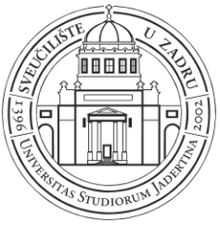University of Zadar
This article needs additional citations for verification. (November 2012) |
Sveučilište u Zadru | |
 | |
| Latin: Universitas Studiorum Jadertina | |
| Type | Public |
|---|---|
| Established | 14 June 1396 (2002 in present form) |
| Rector | Dijana Vican |
Academic staff | 413[1] |
| Students | c. 6,000[1] |
| Location | , |
| Affiliations | EUA BUN |
| Website | www.unizd.hr/ |
The University of Zadar (Template:Lang-hr, Template:Lang-la) is a university located in Zadar, Croatia. The university in its current modern form was founded in 2002, but can trace its lineage to 1396, thus making it the oldest tertiary institution in Croatia and one of the oldest in Europe.
History
The original University of Zadar was founded by the Dominicans in 1396 as Universitas Iadertina, a theological seminary, Iadera being the Latin version of Zadar. The university was a continuation of the University of Dyrrachium, in Durrës (Dyrrhachium), Albania, then Medieval Kingdom of Albania, which had been created around 1380, and then transferred to Zadar in 1396, amid the mounting Turkish threats in South-eastern Europe, thereby becoming the University of Zadar.[2]
It was the first institute of higher learning in the country. In 1807 it ceased to become an independent institution and its functions were taken over by other local universities. In 1956 the University of Zagreb, the country's second oldest university, re-established it as its satellite Faculty of Arts campus. The faculty later became a part of the University of Split. More than six centuries after the original university's founding, in 2002, the Croatian Parliament passed an act to allow for its re-founding as a full-fledged independent university. The new University of Zadar opened its doors to students in January 2003.[3]
Since its reestablishment, the university has continued to grow from strength to strength. The Bologna process was implemented for the 2005-06 academic year as with all Croatian universities. A follow-up study a year later showed that the move greatly benefited University and has increased its profile internationally.[4] This allowed it to engage in collaborative research agreements and student exchange programmes with other reputable universities around the continent. It also has agreements with universities in South America and the United States. First Croatian president, Franjo Tuđman, graduated on University of Zadar on 28 December 1965, which was then part of University of Zagreb.
Faculties
Today, the University of Zadar is the largest integrated university in the Republic of Croatia, which includes 25 university departments:
- Department of Archaeology
- Department of Classical Philology
- Division of Greek Language and Literature
- Division of Latin Language and Literature
- Department of Croatian and Slavic Studies
- Division of Croatian Language and Literature
- Division of Russian Language and Literature
- Department of Ecology, Agronomy and Aquaculture
- Department of Economics
- Department of English
- Department of Ethnology and Anthropology
- Department of French Language and Ibero-Romance Studies
- Division of French Language and Literature
- Division of Iberoromance Studies
- Department of Geography
- Department of German Studies
- Department of Health Studies
- Department of History
- Department of History of Art
- Department of Information Sciences
- Department of Italian Studies
- Department of Linguistics
- Maritime department
- Division of Nautical Studies
- Division of Maritime Engineering
- Department of Pedagogy
- Department of Philosophy
- Department of Psychology
- Department of Religious Sciences
- Department of Sociology
- Department of Teacher Education Studies in Gospić
- Department of Teachers and Preschool Teachers Education
- Division of Elementary School Teacher Education
- Division of Preschool Teacher Education
- Department of Tourism and Communication Studies
In order to organise and promote scientific-research activities, the university has founded four scientific-research centres as its constituent units. These include: the Centre for Adriatic Onomastic Research, Centre Stjepan Matičević, Centre for Karst and Coastal Research and Centre for Interdisciplinary Marine and Maritime Research - CIMMAR.
In addition, there are two active centres for professional and teaching activities: the Centre for Gymnastics and Student Sport and the Centre for Foreign Languages.
See also
References
- ^ a b c O nama (2012-06-14). "O nama". Unizd.hr. Retrieved 2017-03-01.
- ^ "University of Zadar : About us". Unizd.hr. Retrieved 2016-03-08.
- ^ University of Zadar
- ^ Bologna Process at the University of Zadar - A year later. November 2006.

